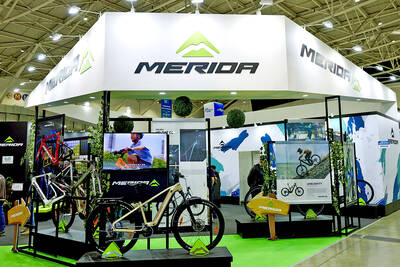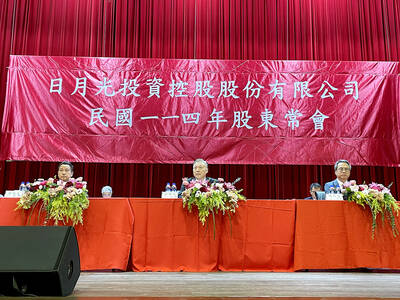Every morning, thousands of construction workers in Qatar start their day by soaking their uniforms in water. The two-minute ritual is part of an important process: When the workers are toiling outside — often at summer temperatures above 48°C — their uniforms can cool skin temperature by as much as 8°C, for up to seven hours.
The uniforms are made by British start-up Techniche UK, which brands them as StayQool suits. Constructed from an outer layer of specially designed mesh, plus a waterproof inside layer, the suits absorb and remove heat through evaporation. They are also adjustable: Workers can add or remove a cooling collar or wrist cuff as needed.
Techniche is not alone in seeing opportunity in apparel designed to beat the heat. With this year on track to be the hottest year on record, a number of start-ups are exploring new technologies and textiles for keeping people cool.

Photo: Reuters
In the US, work is under way to commercialize wearable technology that mimics air-conditioning, while scientists in China are working on highly reflective fabric. With more heat and more heat waves expected in the years ahead, cooling is becoming a holy grail for garment makers.
“As climate change pushes temperatures in extreme directions, demand from consumers for cooling apparel is also increasing at a faster pace,” said Sophie Bakalar, a partner at venture firm Collaborative Fund, which invests in climate-friendly apparel start-ups. “This trend is likely to continue as the Global South industrializes further and consumers have greater disposable income to spend on comfort.”
Extreme heat is not just inconvenient — it is bad for human health and the economy. Heat stress is particularly dangerous for children and the elderly, and can exacerbate existing medical conditions.
Productivity also takes a hit. In 2021, heat exposure nixed 470 million potential labor hours globally in agriculture, construction, manufacturing and the service industry, data compiled by The Lancet showed.
US President Joe Biden has said heat waves cost the US US$100 billion annually.
Research shows that heat waves are likely to become more frequent in coming decades. For companies like Techniche, that is a recipe for growth.
The start-up sells vests, hats, neck bands and other garments with built-in cooling technology to companies and individual customers in nearly 30 countries. Last year, it booked revenue of almost £7 million (US$8.81 million), compared with £150,000 in 2014, when Techniche launched cooling baseball caps as its first commercial product.
“The market is growing enormously,” cofounder and managing director James Russell said.
The company is developing a cooling vest equipped with smart sensors capable of monitoring workers’ biometrics and predicting when they might be at risk of heat stress. It is also working on gear that can absorb heat using phase-change materials, originally developed by NASA to help astronauts maintain a consistent body temperature in space.
On the other side of the world from Techniche’s London office, Chen Renkun (陳仁坤), a professor at University of California, San Diego, is working on the same problem. Except Chen is leveraging his background in mechanical engineering to design clothes that come with air-conditioning.
Just as conventional air-conditioning units keep a space cool by transferring heat outside of it, Chen has crafted palm-sized thermoelectric devices that react to a preferred temperature set by the user. The devices are powered by rechargeable lithium-ion batteries, and are small and flexible enough to be embedded in clothing. They offer a maximum reduction in skin temperature of 10°C.
“Our climate has already changed and this is irreversible,” Chen said.
While cutting carbon emissions is vital, “we also have to find ways to adapt to it, as more extremely hot days will surely come,” he added.
Chen said that his research team has already partnered with a California-based start-up to commercialize the technology. They still need to develop an automated production line that can manufacture the thermoelectric devices at scale, which would lower production costs from several thousand dollars for one shirt to closer to US$200.
In China, researchers from Zhejiang University, Huazhong University of Science and Technology and several other institutes are taking another approach: clothes that reflect solar heat.
The scientists manipulated the structure of polyester using nanomaterials and a redesigned weaving technique, resulting in a material that reflects about 90 percent of the sun’s rays, a 2021 study published in Science showed. A conventional white cotton shirt reflects about 60 percent of sunlight.
The reflective polyester also radiates more infrared energy than regular fabrics, which reduces body temperature. According to the study, the material can stay as much as 5°C cooler than midday ambient air temperatures, and as much as 10°C cooler at night.
While their work has yet to be commercialized, the study’s authors said that their polyester is “readily compatible” with making garments.
Blistering summers have fueled innovations across a wide array of consumer products and wearables. Tokyo-based Kuchofuku Co has developed a fan-equipped baby carrier, while another Japanese manufacturer, A-Mec Co, makes a cooling vest for dogs.
Even with the variety of approaches, most of these cooling solutions face similar limitations, Bakalar said.
The biggest of those is price, which would have to come down to make high-tech cooling gear accessible and appealing. Even at a production cost of US$200 per shirt, Chen’s air-conditioning clothes would be prohibitively expensive for most.
Russell said that Techniche’s cooling suit is priced comparably to mid-end gear worn by construction workers in the US and Europe, but costs more than four times as much as similar workwear in the developing world.
Some cooling clothes come with other trade-offs. To work for eight hours, Chen’s gear is embedded with about 1.5kg of electronic components. Techniche’s cooling vest is 20 percent heavier than a conventional option. Then there is the limited styles on offer, and lingering skepticism from would-be buyers.
“It’s worth noting there are no strict guardrails required to validate brand claims around cooling just yet,” Bakalar said.
All of these impediments are part of what make outdoor workers a good demographic to target: Cooling clothes are more necessity than novelty for them, and companies that employ such workers are inclined to foot the bill.
Nearly 90 percent of Techniche’s revenue comes from sectors such as construction and oil drilling, Russell said.
Nevertheless, today’s niche solutions could be tomorrow’s mainstream fashion. July was the hottest month ever recorded. Over time, entrepreneurs such as Russell expect adoption of cooling clothes to spread from outdoor laborers to almost everyone.
“There will come a time when people will need to wear cooling clothing with sensors in, just to walk across the street,” he said. “It’s not tomorrow, it’s not the next day, [but] it’s absolutely inevitable.”

Greek tourism student Katerina quit within a month of starting work at a five-star hotel in Halkidiki, one of the country’s top destinations, because she said conditions were so dire. Beyond the bad pay, the 22-year-old said that her working and living conditions were “miserable and unacceptable.” Millions holiday in Greece every year, but its vital tourism industry is finding it harder and harder to recruit Greeks to look after them. “I was asked to work in any department of the hotel where there was a need, from service to cleaning,” said Katerina, a tourism and marketing student, who would

i Gasoline and diesel prices at fuel stations are this week to rise NT$0.1 per liter, as tensions in the Middle East pushed crude oil prices higher last week, CPC Corp, Taiwan (台灣中油) and Formosa Petrochemical Corp (台塑石化) said yesterday. International crude oil prices last week rose for the third consecutive week due to an escalating conflict between Israel and Iran, as the market is concerned that the situation in the Middle East might affect crude oil supply, CPC and Formosa said in separate statements. Front-month Brent crude oil futures — the international oil benchmark — rose 3.75 percent to settle at US$77.01

Merida Industry Co (美利達) has seen signs of recovery in the US and European markets this year, as customers are gradually depleting their inventories, the bicycle maker told shareholders yesterday. Given robust growth in new orders at its Taiwanese factory, coupled with its subsidiaries’ improving performance, Merida said it remains confident about the bicycle market’s prospects and expects steady growth in its core business this year. CAUTION ON CHINA However, the company must handle the Chinese market with great caution, as sales of road bikes there have declined significantly, affecting its revenue and profitability, Merida said in a statement, adding that it would

UNCERTAINTIES: The world’s biggest chip packager and tester is closely monitoring the US’ tariff policy before making any capacity adjustments, a company official said ASE Technology Holding Inc (日月光投控), the world’s biggest chip packager and tester, yesterday said it is cautiously evaluating new advanced packaging capacity expansion in the US in response to customers’ requests amid uncertainties about the US’ tariff policy. Compared with its semiconductor peers, ASE has been relatively prudent about building new capacity in the US. However, the company is adjusting its global manufacturing footprint expansion after US President Donald Trump announced “reciprocal” tariffs in April, and new import duties targeting semiconductors and other items that are vital to national security. ASE subsidiary Siliconware Precision Industries Co (SPIL, 矽品精密) is participating in Nvidia